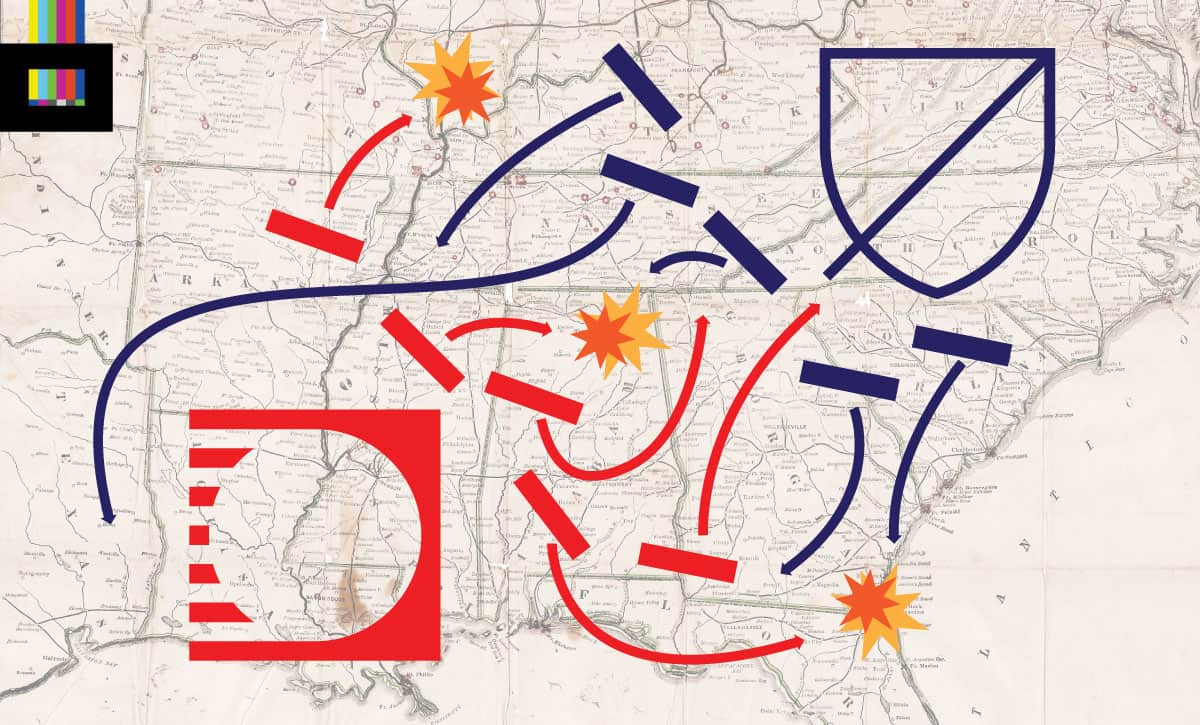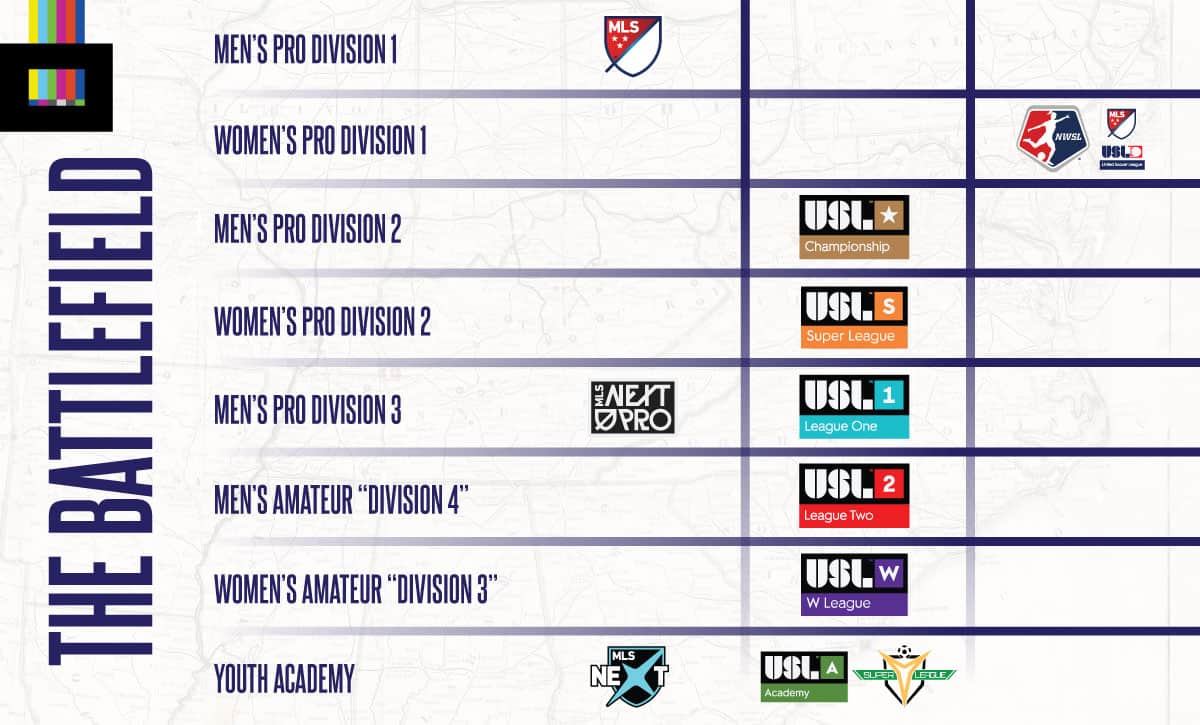
For as long as professional soccer has existed in the United States, there has been drama and conflict between the alphabet soup of entities and organizations controlling the game. The casualties of these conflicts have been hundreds of clubs, and entire leagues, dating all the way back to the original American Soccer League of the 1920s and 30s. And the latest front in the seemingly never-ending American Soccer Wars (that’s #SoccerWarz for all the hip kids) is bubbling just beneath the surface: MLS vs. USL.
Prelude to War
Like many wars throughout human history – soccer or otherwise – this one has its roots in a previous conflict.
Back in 2009, the United Soccer League organization was sold off to a group called NuRock Holdings, with little-to-no input from the team owners. This didn’t sit well with many of them, and a rebellion known as the USL Team Owners Association (TOA) popped up. Spearheaded by Traffic Sports (you may remember them from the FIFA raids in 2015), owners of Miami FC (no relation to the current USL team with the same name), the 9-club group would split off and go on to form the second incarnation of the North American Soccer League, planning to begin play in 2010.
Coincidentally, 2009 was also the debut of the Seattle Sounders in MLS, the first in a wave of expansion teams that was plucked from a lower division league.
These two events were the sparks of an ongoing revival of intense competition and maneuvering between different pro soccer competitions in the US. We’ve seen lawsuits, a combined USSF-operated 2nd division league, alliances, dozens of clubs relocate, switch leagues, go on hiatus, or outright fold, and the entire NASL flash out of existence as a result of this chaos.
Since 2009, a total of nine (ten if you include Sacramento Republic FC who were awarded an MLS spot but later had the bid collapse), organizations have joined MLS from a lower division. Seattle, Portland, Orlando, Cincinnati, Nashville, and St. Louis (USL minority ownership is a part of the MLS bid but USL team branding did not survive) joined from USL, while Montréal, Minnesota and Vancouver came from the NASL (while they did not officially ever play in the league, the Whitecaps were part of the TOA breakaway group and were aligned with the NASL by the time they moved up). That’s more than a third of the league’s makeup. But the practice of elevating proven fanbases with established branding has been an unquestionable success for the league, so who can blame them?
While MLS was hand picking the ripest fruit from the lower divisions, USL was reaping tangential benefits from the glimmer at the top of the pyramid as well. The hype of potentially being the next USL team to get “promoted” to MLS no doubt made the expansion pitch at USL HQ more effective, and has certainly made organizing fan support for new teams easier. That, along with an agreement with MLS that in 2013 brought reserve teams into the league, allowing USL to explode in size to well over 30 teams at its largest.
NASL was not so lucky. A combination of missteps in expansion and ownership choices, and public animosity towards both its competitors, ended with the league effectively closing up shop after the 2017 season, with the remaining viable clubs finding refuge in USL or the fledgling 3rd division National Independent Soccer Association (NISA). USL actually scored a coup near the end of the 2016 season when Tampa Bay and Ottawa announced they’d be switching sides, hastening NASL’s demise. And they’ve have since poached some of NISA’s most successful sides – Miami FC, Detroit City FC and the Oakland Roots.
In 2019, USL launched League One, its professional 3rd Division league, which at the time included several of the MLS reserve teams. But in 2021 MLS shook up the relationship between the two leagues by announcing their own Division 3 league, MLS NEXT Pro (MLSNP), that launched this past Spring, pulling the majority of their reserve teams out of USL’s Championship and League One, and even snagging the independent Rochester Rhinos (rebranded as Rochester NY FC) away from USL. The remaining MLS reserve sides in the USL ecosystem will eventually all migrate to MLS NEXT Pro.
Now the immediate future of the men’s pro soccer landscape is effectively set up as a two horse race (with NISA still trying to find its footing at the D3 level), with the two sides no longer working together.
The Battle Is On

MLS and USL now compete in a soccer space that overlaps more and more each year
MLS and USL now find themselves directly competing for ownership groups, eyeballs, and sponsor dollars at two levels of the men’s soccer pyramid in the USA. And they’re also in indirect competition on the women’s side as well.
Let’s take a look at each area where the two leagues will battle it out:
Men’s Division 3
This is the biggest and most direct conflict between the two is at the Division 3 level. D3 might seem like small potatoes in the grand scheme of things, but the friction between League One and MLS NEXT Pro could have a domino effect that leads to much bigger issues down the line.
Losing the MLS reserve teams themselves to MLS NEXT Pro is actually a net positive for USL. These are teams that nobody goes to see and are otherwise irrelevant outside of MLS hyper-fans interested in seeing developmental players. And USL has enough quality teams at both D2 and D3 to survive the loss of so many sides.
But MLS now fully controls a professional division where they can target ownership groups beyond those ready to immediately join MLS. This is why adding Rochester, and looking to add future “independent clubs” into the league, is such an important detail.
MLS won’t stop expanding as long as they can keep cashing checks for expansion fees. MLS NEXT Pro helps them in two ways on that front. The first is using it as the direct pipeline for future MLS organizations. MLS can simply say to prospective investors “Want to be in MLS? Sure. Start a team in (or move your existing team to) MLSNP first, let’s see how it does, and we’ll go from there.” It could even be a hard perquisite for future D1 expansion (with the MLSNP team eventually becoming the reserve team later on). Make no mistake, MLS NEXT Pro is not only a developmental league for players, it will become a developmental league for markets.
The second is that if and when MLS does finally decide to arrive at a hard cap on the number of teams at the top division, the expansion effort can refocus entirely over to MLSNP. MLS can flesh out its own, insulated minor league pyramid – perhaps someday even including the creation of a second division league.
USL has now almost certainly lost the “MLS expansion hype train” effect that has boosted many of their recent additions. Teams such as Orlando, Sacramento, Nashville and Cincinnati were pretty much launched in USL, and were quite successful, explicitly on the premise of future elevation to MLS.
So now, instead of being the preferred starting spot for the next big MLS expansion team, they must compete with MLS NEXT Pro for markets, venues, and ownership groups. We’ve already seen a contest in Spokane, WA in 2021 between the two leagues, and just this past week Nashville SC announced their reserve team in MLSNP would be placed not locally, but in Huntsville, AL, effectively taking a solid market off the board for USL.
Academies
Both MLS and USL operate youth academy leagues – MLS NEXT and USL Academy / Super Y League. With countless youth umbrella organizations all over the country, this is less of a direct battleground but still an important one, with premier organizations having to pick and choose which outfit to tie themselves to. MLS adding a professional league into their setup, connecting their academy structure directly to the first division, definitely gives MLS an advantage when it comes to youth clubs that aren’t tied to an existing pro team looking at which way to go.
The Women’s Game
The women’s game is where there isn’t a direct confrontation, but the involvement of MLS and USL still could cause some intrigue. MLS has no direct women’s soccer interests, but three of their team ownership groups (Houston, Portland, and Orlando) own National Women’s Soccer League (NWSL) teams in their markets. Two USL organizations, Louisville and North Carolina, also own NWSL teams.
In addition to their amateur W-League, in 2021 USL announced the Super League, a Division 2 women’s pro league planning to launch in 2023 with 12 teams (none officially announced as of yet). Intriguingly, D.C. United is apparently planning to launch a team in this league, one that would compete locally with the more established Washington Spirit in the NWSL (a team that currently has a ground sharing deal at DCU’s stadium).
The Super League has also announced that it plans to play on a Fall-Spring calendar, aligning better with the international calendar than the NWSL currently does (at the time of writing, many NWSL teams have been without international players, as the league has played through major tournaments such as the Women’s Euros, W AFCON, Concacaf W Championship and Women’s Copa América).
With a more player-friendly calendar, potentially competitive wages, and some recent stumbles/scandals from NWSL, the Super League could shake up the landscape of women’s pro soccer in the US if the pieces fall a certain way. It’s definitely worth watching where MLS outfits in particular choose to spend their money if/when getting into the women’s game.
MLS vs. USL: Endgame
What does all this mean for the future? It means USL may very well take bold steps to differentiate itself.
USL has made big strides since the NASL exodus on things such as sponsorship and streaming/TV (even recently pulling higher ratings on ESPN2 than MLS national games on the same weekend). But it’s still a league that relies heavily on ticket sales and expansion fees to keep things running smoothly. The hook of possibly someday getting selected to move up to MLS drove a lot of interest from investors and fans in the last decade for USL. But now what?
With MLS building out its own American style “minor league,” and little realistic hopes of any USL side getting elevated to MLS anytime soon, the league definitely needs to amplify what makes it different. If they can’t sell investors on “why should I put (or keep) my team here?” and fans on “why should I watch and/or buy tickets?,” things could start to unravel fairly quickly. But they must tread carefully.
USL has already publicly floated moving to the European calendar and implementing internal promotion and relegation on the men’s side as ways to move forward. These types of changes, if done smartly, could not only solidify USL but seriously elevate it.
But these are also the kind of things that, if done recklessly, could send the league towards a downward spiral into disaster. One misstep, or an injection of unneeded ego and bravado into the equation could spell doom for not just the league but many clubs as well. Yes, USL has done more of the ground work in building a robust infrastructure and substantial base than NASL ever did. They’ve certainly walked more of the walk. But as someone who lived through the NASL collapsing in on itself and lost both the club they loved *and* their job on the same day, it’s setting up to be a scary time for the game and everyone in it. If USL goes too far, takes one risk too many in an attempt to stand out, it could lose much of the ground it has gained.
Ideally, there is space for everyone. MLS gets its developmental pyramid and USL continues to grow and thrive in its own space as a place for “independent/authentic” soccer, and everybody wins. The darker path, where USL tries (and fails) to upend the status quo in a frantic effort to compete, could leave us with only a smattering of minor league outfits and a soccer nation much worse off than it is now.
200+ Channels With Sports & News
- Starting price: $33/mo. for fubo Latino Package
- Watch Premier League, World Cup, Euro 2024 & more
Live & On Demand TV Streaming
- Price: $35/mo. for Sling Blue
- Watch Premier League, World Cup & MLS
Many Sports & ESPN Originals
- Price: $9.99/mo. (or get ESPN+, Hulu & Disney+ for $13.99/mo.)
- Features Bundesliga, LaLiga, Championship, & more
2,000+ soccer games per year
- Price: $4.99/mo
- Features Champions League, Serie A, Europa League & NWSL
175 Premier League Games & PL TV
- Starting price: $4.99/mo. for Peacock Premium
- Watch 175 exclusive EPL games per season
110+ channels, live & on-demand
- Price: $59.95/mo. for Plus Package
- Includes FOX, FS1, ESPN, TUDN & more






















dave
July 31, 2022 at 9:24 am
Wrong wrong wrong. The entire problem is thinking about it in terms of “markets.” A Major League Soccer team’s “Next Pro” team– basically an academy team, doesn’t “take up a market.” Like you say, no one cares about MLSNP except for MLS superfans, if such a thing exists (“Go, Corporate Single Entity League Managed Side, Go!”).
USL is going to keep doing its thing. Eventually, there might be 100 sides in USL. MLS, despite all its maneuvering to try protect itself (read the USSF First Division regulations– I mean they were clearly written to protect MLS, and then there is the thing where they are so afraid of being exposed by the Open Cup that they essentially rig it (they keep a “second wave” in reserve to mop up any lower division teams that escaped, and I wouldn’t be at all surprised if USSF/MLS “adjusts” the draw in certain cases to protect MLS sides)) basically is going to have to join up or fade away. I don’t care about MLS, I will never care about MLS, and that’s just fine.
Asko
July 26, 2022 at 10:06 pm
Since my city obtained a USL franchise, I can recall maybe watching 5 MLS games in last 5 years on TV. I either would go to my local game or more recently just watch it on ESPN+…Therefore, IMO, USL is only hurting MLS in terms of TV viewership. Reading some of the comments here, there is a MLS franchise 1.5 hours away and 3 hours away. It never crossed my mind to go and see the game live. If USL does get pro/rel, it has to come with some strong financial backing from a TV contract. It would get more notice and respect from an average fan.
Bill
July 21, 2022 at 5:33 pm
Well this is an embarrassing article.. “War” ?
This line to start the article:
Prelude to War
Like many wars throughout human history – soccer or otherwise – this one has its roots in a previous conflict.
That is very very poor in so many ways…
Roberto
July 21, 2022 at 2:27 pm
The reason I disagreed with how this article was framed, is that there is no war. The MLS and the USL play in different markets. There is room for both. Someone already pointed out the that the MLS is concentrating on the bigger markets, leaving plenty of room for the USL in smaller markets. I do not regularly check USL attendance but some of the teams are getting 10,000+ to their games. Those teams should be successful.
jasco11
July 20, 2022 at 2:50 pm
USL is setting itself up to be the perfect avenue for pro/rel outside of MLS. Being the home for “independent/authentic” local soccer clubs, with the ability to promote itself to a tier right under MLS, would be extremely helpful in growing interest in soccer in general across the country with people being able to pick an entry point with a highly localized club and go from there. Let MLS handle the top tier and being a player in the world market separately. They can keep their own development pyramid and recruit players from there as well as the USL.
This would inevitably put people in the awkward position of supporting two separate clubs, one USL and one MLS but being as the setup and goals for each would be so drastically different I could absolutely see it working.
Yespage
July 21, 2022 at 8:24 am
Except can the much smaller squads afford to move up and travel across the country? If USL does continue to grow, that disparity will grow between rungs.
Leo
July 21, 2022 at 10:32 am
In England, the English Premier League manages the top division, whereas the English Football League manages the 2nd, 3rd, and 4th divisions. Similar to MLS and USL. The only difference is the absence for promotion from USL to MLS. But that barely is relevant, the best players from the top division of USL surely will jump to an MLS team if they show enough qualities. MLS can invest freely buying the best players of USL as there is no risk of relegation. It’s a perfect symbiosis.
Mercator
July 21, 2022 at 11:24 am
There just aren’t as many people in these places as you think. Half of Americans live in something like the biggest 40 cities – 30 of them are already in MLS. Under 20% live in the next 60 biggest cities (41-100). For most people, their local club will still be an MLS club, not a USL one.
JP
July 21, 2022 at 12:03 pm
Yes, this debate is very silly. Awareness of USL and other lower leagues might have a decent following in their communities, but economically, cannot sustain it being anything other than a very niche league without that awareness on a larger scale across the country.
It’s probably most like minor league baseball and the various minor hockey leagues scattered across smaller cities. Ok local following, non factor outside that immediate area. No large television or streaming rights will follow. Enjoy these leagues for what they are, low cost entertainment option for people too far away from their State’s professional franchise (or don’t have one) to attend often or who just don’t want to pay hundreds of dollars per seat.
USL would never win a “war” with MLS
Mercator
July 21, 2022 at 12:29 pm
Of course not, I just take issue with a lot of commentators who imply USL is really out there reaching soccer fans in a way big corporate MLS cannot. The US is an urban country, even at 30 clubs, the MLS is probably close to having a majority of Americans in an MLS market. The USL, even if it expanded to the next 60 biggest cities, still wouldn’t reach half as many Americans as the MLS. There are 10 times the number of people in Dallas compared to El Paso – MLS Dallas is doing far more to reach US soccer fans than El Paso. For young US talent, Dallas is working with a pool 10x bigger than El Paso. A club in Huntsville Alabama is great and all but it doesn’t move the needle nationally – getting NYCFC off their baseball field would do far more given the size of NYC.
TheOriginalTom
July 21, 2022 at 12:48 pm
The thing is, how precise is that statement? Is the Dallas/Fort Worth metropolitan area one city or two, or more? If a person lives 45 minutes drive from the MLS team’s stadium still really in that club’s catchment area? I’m a fan of the Colorado Rapids and go to a lot of games, but I can see why those in Colorado Springs, over an hour and half away, want their own minor league team.
Mercator
July 21, 2022 at 1:58 pm
Colorado springs is a separate metro area, and about 6x smaller than Denver. This is kind of the point, you would need about 6 clubs like Colorado Springs to reach as many people as the one MLS club in the region.
Trevor
July 21, 2022 at 3:50 pm
Cities like Dallas are bigger but FC Dallas also competes with Cowboys, Mavericks, Rangers, Stars, SMU and TCU, not to mention super star concerts, theatre and other performances. No wonder the average attendance for FC Dallas was 14Kin 2019. Most USL clubs are the only game in a smaller town or share the stage with minor league baseball which is entertaining but winning is not important. In USL the level of play is very high, (Note Sacramento beating multiple MLS teams to get to the Semi-finals of the Open Cup and recent six and seven figure transfer fees to Europe and MLS for players like Luna and Henri) and winning matters. With little competition for entertainment dollars teams like Sacramento, New Mexico, El Paso and Louisville can thrive, not just survive. USL wont take market share from MLS cities but to think that MLS will eat into the market share of strong USL teams is to not appreciate the strength of these teams in these USL markets.
Roberto
July 20, 2022 at 8:26 am
Interesting article, the headline though is the kind tabloids use, misleading, almost enough to cause a person to skip the story.
David
July 20, 2022 at 5:00 am
Great article. Thank you.
Frank
July 20, 2022 at 5:16 am
I’m suprise the MLS didn’t started a Women’s League by now, the NWSL beside a couple clubs are nothing.
On the MLSNEXTPro TV coverage the worse I ever see, one or two cameras and to far from Field play. I hope AppleTV can make a improvement.
Buckles
July 19, 2022 at 8:07 pm
There is no war. Nobody follows USL. That being said, leave them be. The more the better.
Joe V
July 20, 2022 at 12:11 pm
While you are correct there is no war, to say no one follows USL shows the ignorance of the basic MLS fan. Just a couple of weeks ago, Detroit and El Paso played on a Saturday at noon on ESPN and gained close to 200k viewers. The following week Louisville and Hartford drwe nearly 150k on a beautiful day at 1 PM on a Saturday. I have seen several matchups on MLS tat do basically the same numbers. Several teams like Louisville, New Mexico, Sacramento etc are drawing 10k a game. If they find their own lane, they will be fine. The bigger problem is Garber will eventually want all of it and has stated so.
Sean
July 20, 2022 at 3:07 pm
If there’s an article about MLS, a Detroit City fan will always be there to be an a-hole.
It’s like saying Bloody Mary into the mirror three times.
You guys are absolutely insufferable; although I must say I take a lot of pleasure in the fact that DCFC is now a franchise despite all the trash talking you guys did for almost a decade about independence.
charlie
July 20, 2022 at 3:30 pm
Your the one being an a-hole. This guy made a good point.
Buckles
July 20, 2022 at 5:08 pm
The tv numbers aren’t good and MLS draws more in the right time slot and network. That’s being said, MLS draws more fans to their games physically as well. I think USL is fine. It’s good that they are around and I’ve watched some of the games. The competition isn’t great. I guess the hardcore domestic soccer fan from the area will appreciate it somewhat. MLS doesn’t pull great tv numbers either, but they do get fans to the park for the most part. Going to be hard for USL to keep a consistent product long term. It’s already hard for MLS and they have millions and are considered top flight for America.
Edwin
July 19, 2022 at 5:12 pm
I agree on the war aspect being silly. It’s not really a war at all. MLS is clear, I also disagree that most fans want Pro-Rel. Most beyond a small fanatical vocal group on social media advocating for it don’t care one way or the other.
They like the idea of seeing the club they love to see at the stadium play. Doesn’t matter the league etc. The one shared goal them we us all have is wanting the broader US Sports ecosphere to take to the sport the way they do with leagues like NFL and NBA.
ChrisSao
July 19, 2022 at 4:03 pm
Just so you know the USL Super League, or USLS, is trying for Professional Division II sanctioning, not Division I. They want to be right under NWSL, not fight with it.
ChrisSao
July 19, 2022 at 4:04 pm
I mean that you have the graph set up like USLS is trying to be DII even though in the article you say they are DII. Just confusing for some people who might not know or fully read.
jason
July 19, 2022 at 12:56 pm
Does any other country have a situation like this? You don’t see a renegade english league anywhere. There is a very direct structural pyramid. And nobody breaks from it. I think the whole thing is silly. We need a pyramid where everybody is a part of that is direct. Maybe MLS can buy USL perhaps. Do something. Lets leave these types of rival league squabbles for golf and pro wrestling
Eplnfl
July 19, 2022 at 4:18 pm
While I enjoy and applaud the USL for what they have done, the article makes me fear for the future. Any “war” may well set back US soccer which we all don’t want to see happen and hurts both leagues. A true divisional structural with pro/rel is something the vast majority of fans want but simply can’t happen unless MLS owns the entire lower division system. However if they did that would ruin the fun the USL brings us now.
TheGreatestOne
July 20, 2022 at 12:47 pm
Does it matter what any other country is doing? The US is BIGGER than the entire EU. Comparing what the US does to any single country is ludicrous. England has a huge soccer pyramid, but it’s also a country with the population of Texas and California combined in a land mass the size of Alabama. This isn’t even apples to oranges, it’s apples to trampolines.
GL
July 21, 2022 at 5:05 am
India is even crazier.